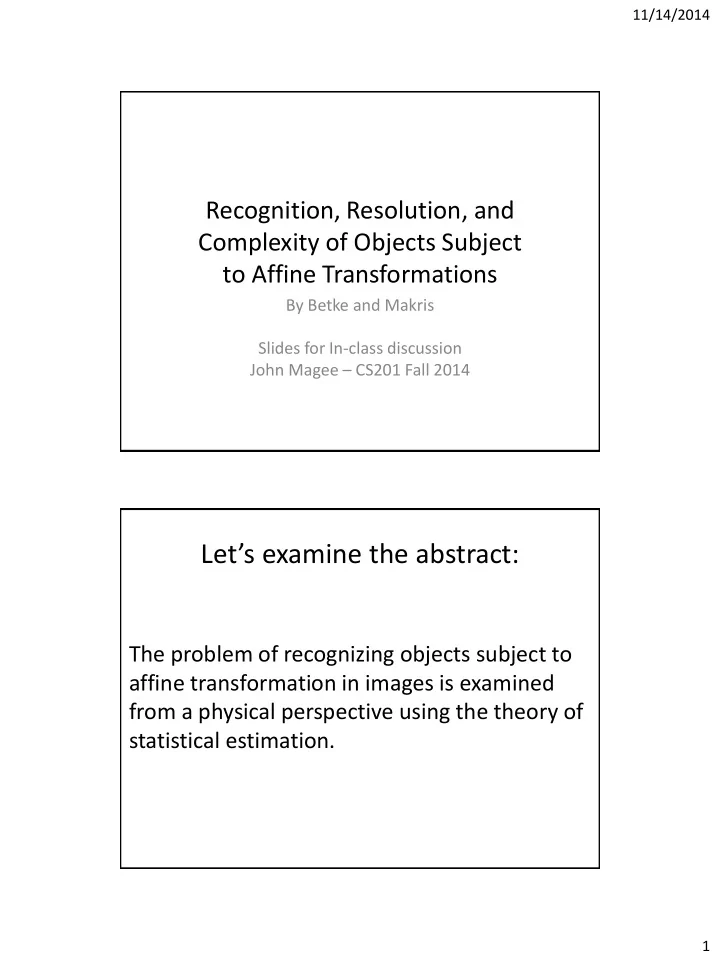

11/14/2014 Recognition, Resolution, and Complexity of Objects Subject to Affine Transformations By Betke and Makris Slides for In-class discussion John Magee – CS201 Fall 2014 Let’s examine the abstract: The problem of recognizing objects subject to affine transformation in images is examined from a physical perspective using the theory of statistical estimation. 1
11/14/2014 Focusing first on objects that occlude zero-mean scenes with additive noise, we derive the Cramer-Rao lower bound on the mean-square error in an estimate of the six-dimensional parameter vector that describes an object subject to affine transformation and so generalize the bound on one-dimensional position error previously obtained in radar and sonar pattern recognition. We then derive two useful descriptors from the object’s Fisher information that are independent of noise level. The first is a generalized coherence scale that has great practical value because it corresponds to the width of the object’s autocorrelation peak under affine transformation and so provides a physical measure of the extent to which an object can be resolved under affine parameterization. 2
11/14/2014 The second is a scalar measure of an object’s complexity that is invariant under affine transformation and can be used to quantitatively describe the ambiguity level of a general 6-dimensional affine recognition problem. This measure of complexity has a strong inverse relationship to the level of recognition ambiguity. We then develop a method for recognizing objects subject to affine transformation imaged in thousands of complex real-world scenes. Our method exploits the resolution gain made available by the brightness contrast between the object perimeter and the scene it partially occludes. The level of recognition ambiguity is shown to decrease exponentially with increasing object and scene complexity. Ambiguity is then avoided by conditioning the permissible range of template complexity above a priori thresholds. Our method is statistically optimal for recognizing objects that occlude scenes with zero-mean background. A few parts from Introduction We also derive the general Cramer-Rao lower bound on the mean square error in an estimate of the six- dimensional affine parameter vector that describes the 2- D position, rotation, dilation, and skew of an object in a zero-mean scene with additive noise and so generalize the bound on one-dimensional position error derived previously in radar and sonar pattern recognition. … Since the recognition problem is inherently nonlinear, a global optimization procedure is necessary for its solution. We develop a global search method based on simulated annealing. 3
11/14/2014 Now let’s examine some sections and figures 4
11/14/2014 5
11/14/2014 Match Functions 4. Recognition as a Parameter Estimation Problem We use the six-dimensional vector to describe rigid body motion and linear distortion of an object q in an image with position, rotation, contractions sx , sy , and skew α which vanishes in a rectangular Cartesian coordinate system. 6
11/14/2014 7
11/14/2014 5.1. Two-Dimensional Position Resolution We first derive the lower bound on the error for any unbiased two-dimensional position estimate of an object with known rotation, contraction and skew. 5.2. Angular Resolution To investigate the angular resolution of an object, consider the case when only the rotation θ 0 of the object about some point in the image plane is unknown. 8
11/14/2014 5.3. Contractional Resolution To investigate contractional resolution, consider thecase when only an object’s contractions sx and sy are unknown. 6. The Complexity of Imaged Objects According to standard usage, an object is considered to be complex if it is “composed of elaborately interconnected parts .” We may gather from this that as complexity increases so does the number of interconnected parts. 9
11/14/2014 7. Image Edges There is an important connection between the positional Fisher information of an object that occludes a zero-mean background and “edge -based recognition .” Both require computation of the spatial gradient of the expected object. However, the positional Fisher information integrates gradient factors over the entire object. This includes both slowly varying brightness contributions over the entire area of the object as well as rapid variations at edges that comprise a relatively small fraction of the object’s overall area. 10
11/14/2014 8. Affine Parameter Estimation Using the Normalized Correlation Coefficient 11
11/14/2014 10. Recognition of Flat Objects The normalized correlation coefficient, given in Eq. (40), is invariant to linear transformations of image brightness 11. The Traffic Sign Recognition System Our method’s performance has been evaluated experimentally by applying it to the problem of recognizing traffic signs. 12
11/14/2014 13. The Simulated Annealing Algorithm Since the space of possible solutions of the recognition problem is extremely large, the recognition method described here is based on simulated annealing. Its name originates from the process of slowly cooling molecules to form a perfect crystal. The analogue to this cooling process is an iterative search process, controlled by a decreasing “temperature” parameter. 13
11/14/2014 14
11/14/2014 15.1. The Impact of Object Complexity on Recognition Ambiguity 15
11/14/2014 16
Recommend
More recommend